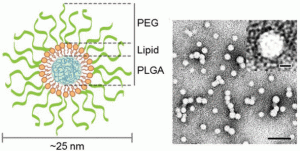When it comes to cancer treatment, smaller can sometimes be better, as a new HOT article published in Nanoscale has shown. New ultra-small hybrid nanoparticles, developed by Jiangfang Zhang and a team based at the University of California, have proven highly effective at delivering anti-cancer drugs in mice – the nanoparticles, which are under 25nm in size, could penetrate deep into the tumours of the mice to release the drug where it would be most effective.
The size of drug delivery nanocarriers has a crucial role in how effective they are at moving through the body: too large, and they will be cleared by the liver; too small, and they will be filtered by the kidneys. Cancer drug carriers work best at sizes below 50nm, where they can more easily infiltrate tumours, but preventing such small particles from aggregating once synthesised can be a challenge. Zhang’s team used both lipids and polymers to make their nanoparticles highly stable, even in physiological conditions – the polymer cores took up the hydrophobic drug, while the lipid coating provided stability and protection from the aqueous environment of the body.
The nanoparticles were targeted to tumour cells by conjugating them to folate ligands – when injected into mice with induced tumours, the number of target nanoparticles present within the tumours was three times that of non-targeted carriers. What’s more, the anti-cancer drug docetaxel could be loaded into the nanoparticles and used to treat the mice, with highly promising results. Over half of the mice treated with the hybrid nanocarriers were still alive 64 days after having tumours induced, a significant extension compared to a clinically used drug treatment.
Read the full article here:
Ultra-small lipid–polymer hybrid nanoparticles for tumor-penetrating drug delivery
Diana Dehaini, Ronnie H. Fang, Brian T. Luk, Zhiqing Pang, Che-Ming J. Hu, Ashley V. Kroll, Chun Lai Yu, Weiwei Gao and Liangfang Zhang*
Nanoscale, 2016, Advance Article
Susannah May is a guest web writer for the RSC Journal blogs. She currently works in the Publishing Department of the Royal Society of Chemistry, and has a keen interest in biology and biomedicine, and the frontiers of their intersection with chemistry. She can be found on Twitter using @SusannahCIMay.










